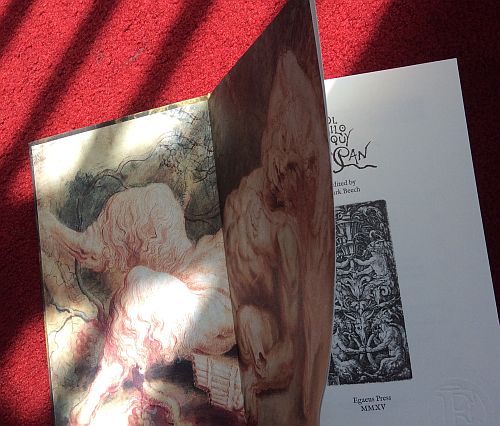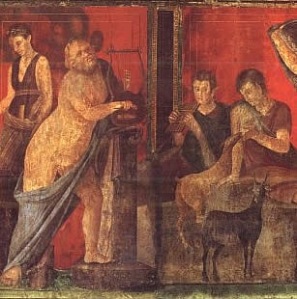SOL ILO QUY FOR PAN

SOLILOQUY FOR PAN – Edited by Mark Beech
Egaeus Press MMXV

A real-time review by Des Lewis
I have just received this book as purchased from the publisher.
Anthology: Stories and Artwork
A distressed book to die for. Holding it is believing.
I intend to real-time review this book and, when I do, you will be able to find it in the thought stream below or by clicking on this post’s title above.
The Transfiguration of Mister PunchWith 8 comments
Transactions of the FleshIn "Adam Golaski"
Aickman's HeirsIn "aickman's heirs"
25 thoughts on “SOL ILO QUY FOR PAN”
The following video can be played from here: https://dflewisreviews.wordpress.com/2015/06/16/sol-ilo-quy-for-pan/#comment-4750


IMG_0467

►
- And indeed the next brief item provides that leap of faith…
THE DEATH OF PAN by Lord Dunsany
“And at the sound of their laughter Pan leaped up…”
Sorry if that is a plot spoiler.
- MEADOW SAFFRON by Martin Jones
“‘Thy coloured members, men by night inspire,’ she began, her voice deceptively soft.”
An intriguing tale upon which my mind is still working. Following closely the previous Insole story, it seems to convey a similar interface of wild woods and ordinary residential property, and here the sexual politics between the houses’s husband and wife and her Sapphic desires entail importation of a second woman and, later, an unexpected third woman like a nymph appears from the woods revealed by the light of the security system suddenly being ignited. And there are some graphic scenes that I can’t help relating to my concurrent reading elsewhere.
- But there is also a book being read aloud in the Jones story, ostensibly, a book from Ancient Greece about Melinoe. I cannot help remembering again that, from some perhaps preternatural cause, I am indeed concurrently real-time reviewing a collection of stories inspired by ‘The King in Yellow’ and its mysterious, frightening book-within-a-book reminds me strongly of the use of the book being used in this Jones story and its plot’s lethal happenings and the characters’ interactions and Melinoe etc, all very reminiscent in some oblique way with various aspects of Pulver’s Chambers work. I am left bemused but uncannily satisfied. And I wonder again at the interface between the priapic Great God Pan and the King in Yellow with tattered cape hiding his own ‘coloured member’?

THE LADY IN THE YARD by Rosanne Rabinowitz
“So where was the lithe leaping boy?”
Look to this book’s earlier ‘lithe tenant’?
This accretiveness of a satisfyingly leisurely story settles around Suzy, around many aspects surrounding her life, many androgynous objective correlatives, telling of her missing three toes on one foot as a result of an accident, thus bullied as ‘Mutant Sue’, seeking transcendence or meaning amid the influence of her Jewishness, interest in mythology and science fiction, while living in a run down area where the derelict swimming pool eventually transforms into something like Jonathan Wood’s under-lake. Those aspects involve, inter alia, a book within the book like the previous story, a singing wisteria, cannabis joints, flutes, Peter Pan, Panisca as the female Pan, listening to late night radio, a Lady with mutable wings, cavorting with mixed-sex naiads, Wyndham’s Chrysalids, eventually reaching a healing of her arguably syrinx-like toes by a rapprochement with these aspects. But is healing worse than the original wound, as even a miracle of such healing condemns her with its own suspectness of mutancy?
A still-resonating ‘dying fall’ of an ending, still reaching toward its own gestalt from these many barely graspable aspects, a gestalt within the book’s overall gestalt, an overall gestalt which is also still forming within as well as beyond the traditional shape of Pan himself.
“Wee wee wee all the way home.”
A PUZZLING AFFAIR by Ivar Campbell (1914)
“I was too much of a man; the animal in me was dead and only its ghost survived, by whose dim radiance I faintly knew that to yield was to discover a wonderful happiness which is the beast’s.”
I show above and below photos of my ‘Yieldingtree’ in a secret glade near where I live of which regulars on my blog or Facebook page will only be too aware!
This story is another wonderful discovery for ‘Soliloquy for Pan.’ And indeed the story is not really a story but an agonising soliloquy for Pan or against him, for and against communion with trees, by turns. It is a flailing of fear and love by the hylophobic narrator, couched in truly haunting meaty paragraphs of text. I empathise with the whole thing, except his dog and the later chopping! But, thinking about it my Yieldingtree seems to embody his dog as well as his version of Pan…
Sorry my appreciation of the Campbell work is a bit too personal, for, objectively, it is a genuine must-read and eye-opener as provided here for us by Egaeus. And I empathise with this, too: “…it is as though I were working against time: this must be done quickly if it be done at all.” With the story, it is consumption, with me, something else.

- SOUTH-WEST 13 by Nina Antonia
“But then, I have always known there was music in the rain and the sighing of souls in the trees.”
This is a highly engaging wordworm of a brief documentary story that includes a variation on Howard’s earworm as well as on Insole’s interface between civiilised thoroughfares and Pan’s domain. In South London, it also seems to distil something else from Rosanne Rabinowitz’s Lambeth North story. Its ultimate strength, though, is its symbiotic connection with Marc Bolan…
[I thought it appropriate to show below a photo I happened to take earlier today and already on my Facebook page and blog. Not in a wild woodland but on a busy thoroughfare near where I live.]

- IN CYPRESS SHADES by Mark Valentine
“We agreed in the end on some discreet chamber music. I had a sense that Hobbes only gave in because he didn’t really think it mattered.”
And perhaps this author puckishly didn’t really think that the sylvan spa performance itself of COMUS – A MASQUE by John Milton warranted a whole story devoted to it. At first, I thought this was some Paniac drama festival that often climaxes fiction works by Powys, Byatt, Reggie Oliver or me – or music by Rutland Boughton. It is a wittily engaging description of its preparation, though, the organising characters involved, a location’s ambiance, and make-up instead of bespoke heads … But it diverges into a intoxicatingly heady scene, half dream, half reality, I sense, where the heads and the make-up of passers-by become subtle masks where the joins cannot be seen. For me, a sort of humanised procession of characters from Rupert the Bear. Or from Chambers’ musical words of meaningful atonality in The King In Yellow, another fiction about masks with a play or masque in it.
“–there is something of a dance about them, a masque of pale dancers, a sarabande of stately wraiths.” - HONEY MOON by D.P. Watt
“She leapt upon him from behind,…”
A mildly amusing, but ultimately uninspiring, honeymoon story. A honeymoon to an outlying part of Scotland in a cronk of a car, where they plan to first consummate their marriage. The nature of the work seems to be the end bracket of the brackets at each end of the fiction in this book with a similar type of tale as that by R.B. Russell. And this one seems conveniently to answer the question I posed about Pan at the end of my commentary upon the Reggie Oliver story near the start of my review! - SUMMER ENCHANTMENT by Harry Fitzgerald
“A sudden faun leapt out and blinked at me.”
As it should! A leap of faith that I can exist at all!
A fitting short poem as coda to this wonderful, wonderful book of 352 luxurious pages that my bearded face first started blinking at, too, in awed disbelief. Seriously.
As well as generous amounts of artwork and other annotations, there are also the following essays in this book:
THE REBIRTHING OF PAN by Adrian Eckersley
FAUN AND FLORA: A GARDEN FOR THE GOAT-GOD PAN by Sheryl Humphrey
THE ROLE OF PAN IN RITUAL, MAGIC & POETRY by Diane Champigny
AN OLD GOD ALMOST DEAD: PAN IN THE 1940s by Nick Freeman
end


“God of the garden, shepherd of the lea–”
What it says on the lid – from Pan’s priestess to Pan. Shepherd of the lea, though, does not seem to make sense in the context. Pan as some meadowy tender of lambs? Pan as the God of Shepherds, yes, but a Shepherd himself? Then, for some unaccountable reason, I thought the dash must represent something missed out. And what made ‘leapfrog’ suddenly jump into my head? Perhaps the Ghisi picture alongside?
PS: Later, I thought this priestess seems to be trying to be his dominatrix?
My real-time reviews are designed to seek hidden dreams or gestalts in works of fiction or poetry, as well as to describe, interpret and evaluate these works to the best of my ability. Therefore, I shall leave any non-fiction or documentary articles about Pan until I have finished reading and reviewing the fiction.
——————————–
PANIC by R.B. Russell
“Everything smelt of wet earth and sheep.”
A relatively simple style, a chicklit type plot about an electioneering politician who seeks out his old flame in the wilds of the Yorkshire Dales and finds her gone a bit crazy over a big stone. The eventual half-seen denouement is well done in its own terms. It involves her current boyfriend and antics upon the stone that the politician witnesses – giving rise to the story’s title. The most interesting thing is to speculate that panic can cause someone potentially to fail a blood test for suspected drunken driving.
I am assuming that some elements in this story will eventually become important in my own seeking of a gestalt for this book. A gestalt, that is, other than the obvious one of the Great God Pan.
“When you go to a familiar place with someone who is new to it, you tend to re-experience it to some extent through their eyes.”
Not only does that seem to be the perfect description of dreamcatching fiction through the author’s eyes and alongside the reader whom you visualise is the recipient of your review but also that quote seems to echo the act of entering the world that is Reggie Oliver, the fictional maze he has created, the real maze in the grounds of the plot’s stately house like the house in Downton Abbey, a figurative maze, too, that is a setting for an alchemy of sexual antics required to summon Pan, as such antics summoned him in the previous story. This is the wonderful thespian Virtue in Danger world of Reggie Oliver you are entering with me, a story that is also an amusing grotesque satire of various snobbish mores representative of nobility and of generally posh people, the orienteering of sexual politics, theatrical Etonian types now making a living from TV series….
There are people like the narrator who concocts his own backstory as a magick alchemist of the old school, the Marquess of Martlesham, Samuels the chauffeur, and a posh character who seems to morph from gay to hetero – an imputedly parallel magick alchemy from dross to gold – called, by the narrator, at one point ‘a notorious wrong-ender’, all inter-mazed with a Chinese Chippendale Fourposter bedroom, and much more. One ends up wondering whether it was the Statue of Pan in the maze that brought to life the sexual antics of the characters in its vicinity or those actual sexual antics that brought the Statue of Pan to life. A virtuous or vicious circle?
“…and let it fall open to a random page.”
The insanity of the child remembered as Diana. She returns, after many years, to where she was that child, and where her imaginary childhood friend had been Pan with what I imagine (just as strongly as she herself once imagined Pan) are his dryads and naiads in one of the ‘games’ mentioned in her old notebook that she randomly browses, a special game of leapfrog: youth’s forgotten past, upon present’s back, into fearsome future’s remembering.
The return here for her younger sister’s wedding anniversary, later standing with her brother-in-law smoking outside the party’s circle, the self-blame for an ancient tragic accident due to her imagination being strong enough to create Pan who had caused the death of her parents, with only a compensating hope that one parent had not survived briefly to see the other die. I found this whole scenario sensitively handled. Touching and tantalising and transcendent. Growing pains that endure toward an uncertain, almost welcome ‘dying fall’.
PAN WITH US by Robert Frost
“His heart knew peace, for none came here / To this lean feeding…”
A tightly written, highly rhyming, magnificently couched, tantalising, sylvan poem regarding magnificently couched and surgent Pan coming among us. To teach us what? But, at the end of the day / what should he play? / Leapfrog I would say. (My words, not the poem’s).
“The first frost of autumn retreated as the remaining patches of shadow shifted and contracted.”
In a sylvan area without city light pollution, this is a compelling, page-turning, ultimately Pan-rapturous, and (dare I say?) wonderful Science Fictional story where the main protagonist ends up, inter alia, eating that frost. A loving and sexual relationship positively transcending in quality the chicklit or the static leapfrog (cf Reggie Oliver’s earlier sexual alchemy in this book), pervades this story that tells of a Tune as an earworm or parasite form of sound (cf this author’s own ‘Winter Traces’ story) suddenly then accretively taking over and subsuming the world, in a believable tale, for me, of the Internet eventually breaking down and civilisation itself faltering as a result of this Tune.
[Synchronously, a few days ago in a review of a book called Dreamcatcher (another word as an expression of the effect of Howard’s earworm?), I had cause HERE to link to a genuine current news phenomenon of the world hearing trumpet noises and humming!]
John Howard is fast becoming one of my favourite fiction writers of all time.
“So with each story I see another facet.”
This novelette builds powerfully with a shocking visionary and sexual ending, a ‘myth’ channelling its own power of reality simply by being a myth. And we do find each work accretes a new facet of this book’s gestalt, here the insidious accretion itself of a feral character, the son of the main protagonist’s friend who died of suicide if not by suicide. This is a blend of Rucker’s notebook of Pan-summoning then looked at randomly but now become a diary with pages torn out and of Howard’s earworm become a Syrinx’s flute or an airbrushed object we can never really focus on. Except by some grotesque effigy’s ‘fart’ in the climax.
There is a highly haunting genius loci of a derelict canal and its bridge reached by trolleybus “trundling along avenues lined with frosty hedgerows.”
That place eventually becomes the narcissistic crux where self bounces off the back of its own reflection.
The various meetings of the main protagonist and his late friend’s son (and that son’s seductory relationship with the protagonist’s wife and daughter) are probably some of the darkest scenes you will go far to find in literature, with added talk of once working in zoos: “I’ve seen the cage from both sides, you could say.” A Caliban toying with cigarettes. The caressing also of that airbrushed object’s contours. But that’s not half of it.
With my dreamcatching reviews I often find myself “attuned to something greater, something just out of reach, or of having a purpose” even beyond the author’s intention. I strongly have that feeling here.
“…if anything the irrational can enrich Reason, deepening it, fuelling it, providing it with inventive methodologies and vice versa.”
Mythologies, as well as or simply as methodologies, I say.
From Dictynna’s fane, “deep-lurking”, I sense, judging by this mould-breaker of a book as a whole and this brief verse in particular, that the Internet and Pan are “alike foe and friend of man”. We’d all not have “restless watchful eyes”, otherwise.
Messages bouncing off each other in the dark web of enshrined truth and lie.
I cannot possibly do justice to this incredible work. What a discovery! I think I have actually got to know Pan personally and I understand him far better than I have understood him before. A sort of Socratic dialogue, but that should not put you off as it is cast in a fiction or fable or travelogue form, with two Englishmen (the free-thinking narrator and the other who is more appreciative of Apollo than a god like Pan) travelling in Greece (it simply had to be Greece bearing in mind its crucible condition in world affairs today, as if foreordained), and these two men meet Pan, and listen to the most astonishing stretches of speech from him, about, inter alia, the opposites within himself and his worshippers, and, incredibly, this book’s earlier sexual and creative and mythological alchemy is now portrayed as a ‘kneading-trough’ of the Great Mother. Those opposites are (for me) tellingly and explicitly inclusive of the ‘centaur’ – and other wanton creatures. And, in view of that alchemy, a reference to a certain cavorting in a ‘brown river’…
There are witticisms galore, stoical humour from Pan, plus his urbane philosophising, a lot of which reflects upon Godhood, mortality and immortality, the state of mankind and animals – with startling sudden illuminations.
I could go and on about this work. And I have made many pencil lines in the margins of my copy from where I intended to quote in this review. But there were so many brilliant passages, I can’t actually decide to quote any at all!
“I hear that Goat Men come out when it rains.”
Two twelve year old boys out with the school on a field trip, and one of them is aware of an ability in manipulating the fears of others. A fable about fears cumulatively bouncing off each other from mind to mind soon more readily turning into the reality of what is feared.
“Isn’t it cool, the idea of something out here like a real live centaur or…”
“There is an uncouth, outlandish strain throughout the web of the world, as from a vexatious planet in the house of life.”
A preternatural continuation of A.C. Benson’s premonitory theme, a dissertation upon Pan’s ‘trolling on his pipe’ as both his parasitical earworm and glorious melody – at different times more of one than the other – haunt us. This is Nevinson’s kneading-trough of opposites writ large in our world, our lives, symbioses as well as battles. An inspiring, tightly-textured revelation of grasping the nettle, I’d say. Or the ‘conflagrant sun’. A graspable life even when ‘the child too often makes entrance from the mother’s corpse’ and “for all their hurry, they [we] travel back-foremost through the universe of space.” Thus this now is Pan as Shepherd of the Leapfrog, not the Lea.
“Some leap to the strains with unapt foot,…”
“…the prancing image of the god, as indeed now, fascinated and horrified at the same time.”
I am guilty of being a sucker for John Gale prose, its pearlescence, its poppy-drenchings, chrysalites, beryls et al, and this atmospheric story sure sucked me in.
The protagonist, aged the same age as I am today, inherits the house – one with incongruous gothic tower – from his great uncle, a place he visited when a child. He looks askance at the dubious and the ‘distastefully priapic’, and he has a so-called dream that reminded me of first entering Narnia. The Galean visions and the protagonist’s ultimate bitter-sweet subsuming by the ‘goat-eye opal’ is drenched in moonsmoke, moon fire, autumn leaves, “set against a yellow sky”. I personally felt Pan morphing into the King in Yellow, or at least accepting a hoist on his back, then vice versa…
“Dumb animals and shepherds and foolhardy climbers have no orientation to appreciate this degree and substance of change,…”
Sometimes in life, you encounter a literary work that suddenly comes at you from a studied distance and fixes your reading mind with an unflinching concentration. This novelette is one such work of rare special qualities, and it matches its immaculate clause structures and internally audialised phonetics of perfect register with an intense synaesthesia of sensibility. It tells of a group of men who have come to the lake with regular seasonality and its comradeship, story telling, mountain climbing, and its stone head with patrinomial aura of descent and, upon it, for me, Pan-like pointed tumps. A hint of androgyny, too. There is much to pick out from this story, but impossible here. I will just mention the fire, in contrast to the lake’s water and its submerged world that we visit in our minds with one of the men, that spits and snarls in its sappy destruction by living flame. The pangs of death and companionship, constructive self-destructiveness, classical turnings and dying-falls of music, all remind me of Thomas Mann’s two works, The Magic Mountain and Dr Faustus, plus (dare I say?) a masculine version of ‘Picnic at Hanging Rock’ (its original novel that I real-time reviewed HERE only recently).
“The end of summer has a special malevolence all its own, composing empty symphonies of the soul with the music of despair.”
I simply loved this work. A major experience. It also resonated with a personal phrase of mine: A Dead Monument to Once Ancient Hope. (If something is now ‘once ancient’, it is no longer so?)
And the work also echoes the Nevinson in this book, in a glorious way.
“…as the sheep and the goats watched in their stoicism and their ancient intransigent wisdom; the place where the past meets the present at its own eternal crossroad.”
“More real than the body you inhabit, you have been a meadow and a leaf of myrtle,”
This entrancing poem, I’m sure, gives us all, for the historic first time. the true meaning of ‘Pantheism’.
“And a coven of the middle-aged and elderly, creaking and puffing, with rheumatism and damaged hearts, met regularly at solstice.”
…and I am there among them! It seems appropriate that I should first encounter this new Colin Insole substantive fiction on the solstice, today, as I write this and have just read the story itself. This, so far, and I use my words advisedly, seems to be the ‘orgasm’ of this whole book’s ethos, its style, its conjuration of Pan, his worshipers and cavorting companions, changelings and foundlings, his ambiance, here at the interface of residential humanity and the wild caves and woods that border it. A woman who is exploiting that interface ends up destroying it, and finally subsuming herself. Those who love this author’s work will not be disappointed by this Panic apotheosis of it, but I sense that it is what it is, and could only possibly be published in THIS book. Prove me wrong, one day.
The story implies that the town where this ‘interface’ happens is specially unruly, with its modern ways of wild youth and greed and exploitation and, yes, elderly smugness, with barbecues and other crass conveniences. But I sense the wider world is just as inimical as this town, and needs this lesson from Pantheism. I sense, too, a swathe of such modernity being overridden by a more natural swathe of instinct (“Days, months and years seemed to pass in minutes”), like a huge leap of faith, underpinned by astrological harmonics, ‘the alignments of stone and sky’.
A brooding melancholy coupled with a puckish spirit, makes this story of those wild places we can still visit between our houses shudder with potential at the interface of Pan and Man.